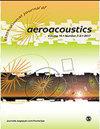Numerical study of acoustic source localization of rotor using a novel discrete noise analysis strategy
IF 1.3
4区 工程技术
Q3 ACOUSTICS
引用次数: 0
Abstract
In order to obtain the influence mechanism of the rotor noise and the local aerodynamic variation under different operating conditions, a novel discrete noise analysis strategy for the acoustic source localization is established. The analysis strategy has two aspects including the blade division method and the noise contribution calculation method. Firstly, the body-fitted rotor blade grids are preprocessed and refined at the division position before the flowfield simulation. Then, based on the flowfield result, the blade grids are divided into several blocks in the chordwise and spanwise directions, and the acoustic pressure of each block is predicted. Finally, a discriminant function for the contribution of the block to the rotor noise is proposed, and the acoustic source localization is carried out. The URANS equations and FW-H equations are used to capture high-fidelity flowfield and rotor acoustic pressure. Parameters such as the block position in different direction on the rotor blade and the collective pitches are quantified, and the relationship between air flow and aeroacoustics is discussed in detail. Some conclusions are obtained by analyzing the BO105 model rotor in hover. The acoustic pressure produced by the leading edge of the upper surface could cancel about 50% acoustic pressure of the remainder of these blocks. Increasing the force at this position will be benefit to the noise reduction. Acoustic source distribution is closely linked to the flow separation near the blade tip: the main acoustic source moves toward around 0.9 R section of the blade in the spanwise direction, and it moves from the leading edge towards the trailing edge in the chordwise direction.一种新的离散噪声分析策略用于转子声源定位的数值研究
为了获得不同工况下转子噪声和局部气动变化的影响机理,建立了一种新的声源定位离散噪声分析策略。分析策略包括叶片划分方法和噪声贡献计算方法两个方面。首先,在流场模拟前的分割位置对贴体转子叶片网格进行预处理和细化;然后,根据流场结果,将叶片网格在弦向和展向上划分为几个块,并对每个块的声压进行预测。最后,提出了块体对转子噪声贡献的判别函数,并进行了声源定位。采用URANS方程和FW-H方程对流场和转子声压进行高保真捕获。量化了转子叶片上不同方向的块位置和总节距等参数,详细讨论了气流与气动声学的关系。通过对BO105模型旋翼悬停状态的分析,得出了一些结论。上表面前缘产生的声压可以抵消其余区块50%左右的声压。增加这个位置的力将有利于减少噪音。声源分布与叶尖附近的流动分离密切相关,主声源沿展向向叶片0.9 R左右截面移动,沿弦向从前缘向尾缘移动。
本文章由计算机程序翻译,如有差异,请以英文原文为准。
求助全文
约1分钟内获得全文
求助全文
来源期刊

International Journal of Aeroacoustics
ACOUSTICS-ENGINEERING, AEROSPACE
CiteScore
2.10
自引率
10.00%
发文量
38
审稿时长
>12 weeks
期刊介绍:
International Journal of Aeroacoustics is a peer-reviewed journal publishing developments in all areas of fundamental and applied aeroacoustics. Fundamental topics include advances in understanding aeroacoustics phenomena; applied topics include all aspects of civil and military aircraft, automobile and high speed train aeroacoustics, and the impact of acoustics on structures. As well as original contributions, state of the art reviews and surveys will be published.
Subtopics include, among others, jet mixing noise; screech tones; broadband shock associated noise and methods for suppression; the near-ground acoustic environment of Short Take-Off and Vertical Landing (STOVL) aircraft; weapons bay aeroacoustics, cavity acoustics, closed-loop feedback control of aeroacoustic phenomena; computational aeroacoustics including high fidelity numerical simulations, and analytical acoustics.
 求助内容:
求助内容: 应助结果提醒方式:
应助结果提醒方式:


